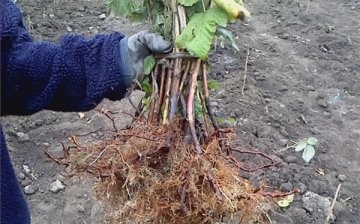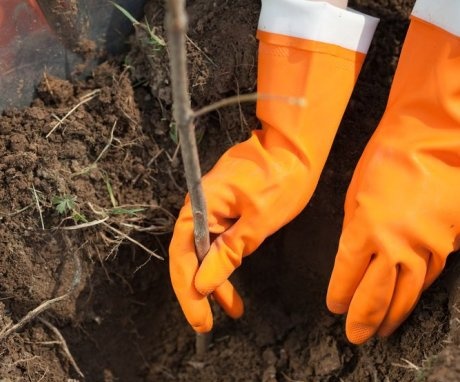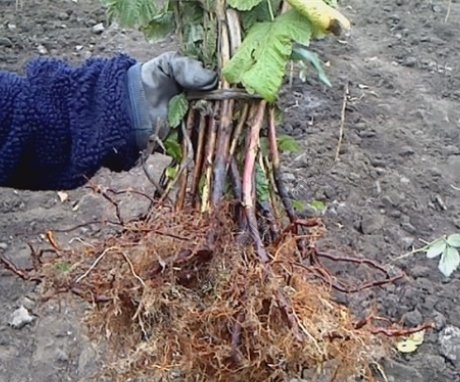Useful information on planting raspberries in spring
Raspberries are a favorite food of both adults and children. In addition, they are full of useful vitamins and minerals. With the arrival of spring, raspberry bushes are rapidly gaining strength and growing. Is it possible to plant raspberries at such an important time for its growth? It turns out that it is possible and it is not at all difficult. In this article, we will analyze the main activities for the correct planting of raspberry bushes in the spring.
Content:
- Choosing a place for planting raspberries
- Soil preparation
- Cooking raspberry seedlings
- Planting raspberries
Choosing a place for planting raspberries
How to choose the right place for planting raspberries:
- Perennial shrubs of raspberries grow mainly in one area, where they were originally planted. Therefore, the selected site for planting should be in a well-lit place.
- Raspberry is a light-loving plant, which means that sunlight in the selected area should be the maximum amount of daily time.
- At the same time, the raspberry bush is very picky about moisture in the soil, and therefore needs regular and abundant watering.
- Raspberries grow well in several shaded areas, so a light shadow is not at all scary for it. Most often, raspberries are planted on the west or east side.
- The selected area should not only be well lit, but also contain a significant amount of moisture in the soil. Well-lit, high places for raspberries are not the best place to plant, as they contain insufficient moisture, which can practically disappear during the dry summer period.
Raspberries should be planted in a row in spring. A little free space should be left between the rows in order to tie the shoots as necessary and pass freely between them for picking berries or treating diseases. This method of planting will provide you with safety during harvesting and will help protect the bushes from breakage.
Many gardeners in the spring plant raspberries in one row, and along buildings or fences.
As a result, planting raspberries near buildings that play the role of good snow retention, you can protect the bushes from freezing and saturate the soil with additional moisture in the spring. In addition, overgrown raspberry plants near buildings can be attached to the walls so that the branches do not fall to the ground and do not break. Excessive wind outside the walls of buildings will also not have a strong effect on the bush.
Soil preparation
For planting perennial raspberries, you should choose areas soil with a good fertile layer... It is thanks to him that the plant will take the required amount of nutrients from the ground for a long time and will be able to do without feeding. In the structure of the root system of raspberries, one can clearly see the predominance of lateral roots, which are distributed over the soil surface, therefore, for raspberries, the soil should not be deeply loosened.
Feeding raspberries:
- When planting raspberry plants, in the spring, you should provide the soil with additional organic fertilizers.
- To do this, you can simply add a certain amount of humus to it; wood ash is also ideal. These types of fertilizers will increase the amount of necessary trace elements in the soil for the active growth of the shrub.
- The best way is to fertilize the soil for raspberries since autumn, but if for some reason you did not manage to do this, you can postpone this event to early spring.
The most favorable soil for the raspberry plant is loamy fertile layers. Such soil and moisture is well permeable and permeable to oxygen. If on the selected site for planting there are nearby groundwater, then the growth of raspberries will be somewhat inhibited. It is better to abandon such a site in favor of another. Strong waterlogging of the soil is also unfavorable for the growth of raspberries. The harvest from such a site will be rather poor, and young shoots will quickly die off.
Raspberries are demanding to the amount of oxygen in the soil, so it is worth clearing the bushes from overgrown weeds. The most vicious enemy of raspberries is wheatgrass, as its superficial rhizomes entwine raspberry roots and prevent air from entering the soil.
If thickets of wheatgrass appear on the site, especially creeping, immediately go out to fight it.
To prevent the growth of raspberry bushes in neighboring areas, some barriers should be made by digging boards, sheets of slate or iron into the soil to a depth of thirty centimeters. Such events will help protect neighboring territories, where other plants may grow from the influx of raspberry shoots. Usually, such fences are made around the perimeter of the site.
Cooking raspberry seedlings
Having decided on the variety of raspberries that you want to harvest on your site, you need to start preparing the seedlings. In early spring, on the shelves of shops and bazaars, you can find a wide range of different seedlings, including raspberries.
Use for planting those seedlings that are recommended by the breeders for growing in your climatic conditions.
By choosing from the provided variety of varieties, the one you dreamed about, you can safely make its purchase. Pre-inspect the root system of the purchased seedling, it should be well developed. In this case, the planted seedling will begin active growth from early spring. If it is impossible to plant the immediately acquired plant in the ground, it should be placed in water. So the seedling will not wither for a long time and will not lose strength for growth. When transporting seedlings over long distances, wrap its root system in a wet cloth. In this way you save the seedlings from the scorching spring sun and evaporation of moisture from its surface.
Landing tricks:
- For planting in spring, raspberry seedlings, one year old, no more than forty centimeters high, are ideal.
- This effect can be achieved by simply cutting off the excess height of the shrub.
- Seedlings should be used for planting in spring with unblown leaves, otherwise all the strength of the plant will go not to strengthen the root system, but to the leaves.
- Early spring is ideal for planting, when the snow only melts and the soil warms up.
Planting raspberries
Transfer the prepared seedlings to the selected and pre-prepared landing site... In the spring, when there is still no grass cover on the ground, it is convenient to arrange raspberry bushes in bunches, on average, seven or even ten in each. With this arrangement, the distance between the beams should be maintained equal to fifty sentiments between each other. Free spaces of up to one meter and even a little more should also be left between the rows located.
Free spaces are needed for smooth movement between rows when harvesting or tying bushes. Planting raspberries in the spring in a staggered arrangement is best suited.
Another way of planting raspberries is a ribbon arrangement:
- With this method of planting seedlings, they are distributed at a distance of up to thirty centimeters linearly, and the recommended space between the ribbons is just over one meter.
- This method of planting involves cutting out excess shoots that are not included in the "ribbons".
- In addition, planting with a tape arrangement provides for the presence of supports or trellises necessary for raspberries. Such supports are easy to install by yourself. To do this, you need to dig in the posts to a small depth along the edge of the lines where the raspberries are located, connecting them together with wire or a strong rope.
- The first row of wire should be located at a distance of thirty centimeters from the surface layer of the soil, and the second - slightly higher, up to one meter from the soil.
- To the stretched wire, you should carefully, so as not to break the bushes, tie up the shoots. Such protection is able to withstand all spring winds blowing in the area.
Despite the chosen planting scheme, the seedling planting algorithm is the same. The planting itself consists in making a small hole or hole in the soil for the location of the root system and placing the roots of the seedlings in it.
When buried root system vertically of installed raspberry seedlings, the upper layers of the soil should be somewhat compacted to prevent the roots from being torn apart by animals and birds. Then it makes abundant watering of the seedlings. We do this procedure with all the seedlings prepared for planting.
When planting seedlings, carefully monitor the location of the root collar to the ground.
The root collar of a seedling is understood as the place where the stem passes into the root. If the root collar is placed deep enough in the soil, raspberry seedlings will grow and develop rather poorly. If the root collar is located above the recommended level above the soil, the basal buds on raspberry seedlings can dry out, and, as you know, young raspberry shoots are formed from them. After planting, you should monitor the soil moisture under the seedlings. If necessary, they should be watered.
More information can be found in the video.

















I planted raspberries last spring. I bought several varieties and planted at a great distance. I left somewhere about a meter between the seedlings. This year, raspberries have sprouted nearby, now there is less space between the seedlings. So it will grow every year and the less often you plant raspberries, the later you will have to cut them.